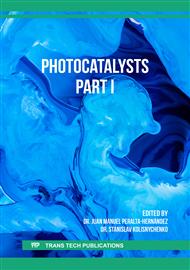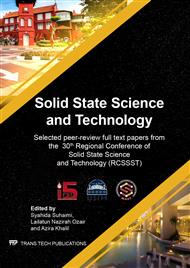p.185
p.192
p.201
p.207
p.217
p.223
p.231
p.247
p.252
Antimicrobial Activity of Photoactive Cerium Doped Zinc Oxide
Abstract:
Biofouling and biofilms exist as ubiquitous, undesirable accumulation of flora and fauna upon a given substrate when being immersed into an aquatic medium. Therefore, a novel antifouling based materials with the incorporation of nanotechnology has been developed for the prevention of biofouling in its initial stage through photocatalytic treatment. This study investigated the antimicrobial properties of photoactive Cerium (Ce) doped ZnO powder and explores its potential properties for future antifouling application. ZnO nanoparticles was doped with 0.4 mol% Ce was synthesized through the combination of modified citrate gelation technique and solid state sintering. The successful preparation of Ce doped ZnO was confirmed by XRD and SEM. The antimicrobial activity of Ce doped ZnO against E. coli and S. aureus was determined through antibacterial susceptibility test by agar well diffusion method whilst its photocatalytic inactivation efficiency against selected bacteria was analysed through photodegradation testing under UV light irradiation. The findings demonstrated that the synthesized Ce doped ZnO powder exhibited antibacterial effect against Gram-positive bacteria (S. aureus) and excellent photocatalytic efficiency to inactivate both Gram-negative (E. coli) and Gram-positive (S. aureus). 2 g/L of Ce doped ZnO catalyzed the 100% disinfection of both bacteria in 180 min of UV light exposure. Thus, this proved that Ce doped ZnO powder has the potential as efficient antifouling agent.
Info:
Periodical:
Pages:
217-222
Citation:
Online since:
July 2020
Price:
Сopyright:
© 2020 Trans Tech Publications Ltd. All Rights Reserved
Share:
Citation:



